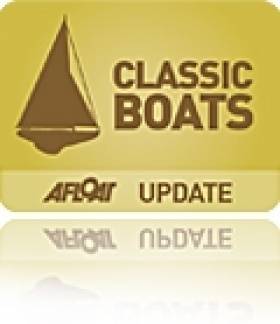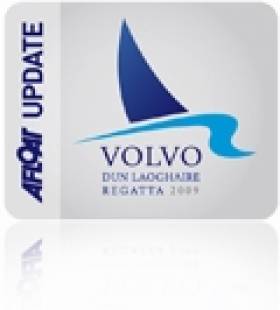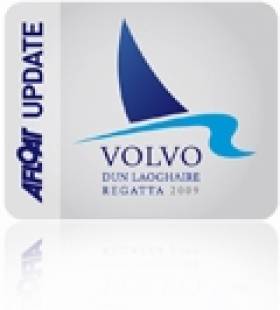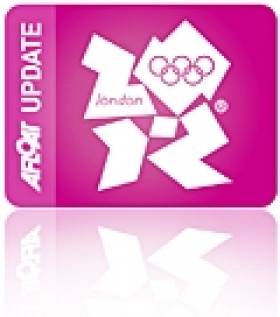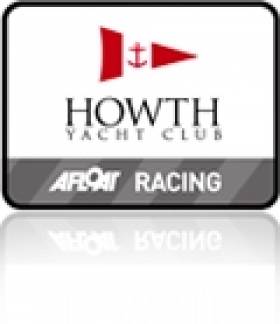Displaying items by tag: Regatta
Last of National Rowing Heads takes place in Belfast Today
There are 148 crews over the three races starting with pairs and sculls, then doubles and fours and finishing in the afternoon with eights and quads. The third race features 35 eights and 26 quads.
The big race of the day, the men's senior eights, which starts at 3.45 pm, will feature a high intensity race between the two Queen's University eights. The A Queen's crew, with new strokeman, Mike Ewing, have been relatively the same crew for the last three years. This is the crew which mounted serious challenges to the victorious NUIG team at the Irish Rowing Championships, narrowly missing out on a national senior eight by a mere few feet on two occasions. The A team's Ewing won a Wyfold cup (men's coxless four) at Henley last year.
The women's intermediate eights should prove interesting with a crew entered from St Andrews in Scotland who will be up against Queen's University Ladies and St Michael's, Limerick.
The men's junior 16 eights sees all the Ulster crews up against each other whilst the men's junior 18 quads sees Blackrock College, Dublin, Shandon ,Limerick and Offaly Rowing Club take on the Ulster schools.
Eight crews will contest the men's Master's pennant (over 28s) with Galway, Bann and Athlone pushing the Belfast-based masters crews, Belfast Boat Club, Belfast Rowing Club and the Lady Victoria Boat Club, all the way. The former Queen's ladies rower ,Frenchwoman Solange Garrais is bringing a men's Masters and a women's Masters quad from Aviron Grenoblois, France to compete.
The 10.45 am and 13.15 pm races start at the Albert Bridge in Belfast and finish at Queen's boathouse at Stranmillis. The 15.45 pm race starts at the Odyssey building in Belfast Harbour and finishes at Queen's boathouse at Stranmillis. There are viewing points along the full length of each race.
The official start to the regatta season takes place on Saturday 2nd April with the Neptune regatta at Islandbridge, Dublin.
Click this link for Irish Rowing detailsClick this link for the Latest Rowing News
Unique footage of 1926 Dun Laoghaire Regatta Uncovered
Here's a unique glimpse of a post World War One Dun Laoghaire Regatta in rare newsreel recently archived by British Pathe (below). The shots taken on August 2nd 1926 show a mixture of long shots of yachts sailing across Dublin bay. There's definitely lovely shots of Dublin Bay 21s enjoying a tight race, a brave gybe by a Dublin Bay 25 at the harbour mouth plus shots of some Howth 17s.
There's panning shots of in harbour rowing races and high angled shots of men diving off the side of a boat and into the harbour. The swimmers race the length of an area cordoned off by rowing boats with spectators watching from the boats. There is also a shot of women's swimming race and some diving too.
We'd like your observations on these shots, particularly any details of the large committee boat dresssed overall. Leave your comments below. Enjoy.
Scroll down for the clip.
Entries Roll in for Volvo Dun Laoghaire Regatta
Forty entries are already in for Volvo Dun Laoghaire Regatta, a fixture widely expected to be the biggest in Ireland this season when it sets sail on Dublin Bay in July.
Organisers are expecting up to 500 boats to keep it on a par with the 2009 event. The early entries, 11 weeks ahead of the entry deadline, is being taken as a thumbs up by competitors for the fun and vlaue theme of this year's VDLR.
So far 22 different clubs have entered from six countries. The bulk of the fleet is Irish but there are early entries from France, Isle of Man, UK, Wales and Northern Ireland. Another good turnout is exepcted from Liverpool and Holyhead for boats competing in the IRC Lyver Cup Race across the Irish Sea. Ten boats from the Clyde will also compete on the Bay.
Cork's Conor Phelan the skipper of Jump Juice is one of the first Royal Cork boats confirmed.
Two handed IRC racing makes its debut in July's Volvo Dun Laoghaire Regatta organisers have also confirmed. Click HERE.
On the dinghy front, the Fireball class has confirmed it will be running an'Open Championship' within the regatta, an event that follows the class world championships in Sligo in June.
Dun Laoghaire Announces Debut of Two Handed Fleet for Volvo Regatta
Two handed IRC racing makes its debut in July's Volvo Dun Laoghaire Regatta organisers have confirmed this week. Up to six boats have expressed interest in the new intiative and the organisers say the class will race over a mix of coastal and windward leeward courses. It's an exciting development for the regatta that is already receiving a flow of entries 11 weeks ahead of the entry deadline.
Double handed Class captain Olivier Prouveur of the National YC says boats that have expressed an interest so far are the regular ISORA participant Mojito from the UK, Team Windmill (J109), JBellino (J-122), Dinah (Barry Hurley's modified JOD 35 with which he won his class in the OSTAR 2009) and Oystercatcher (second in the two-handed class in the Round Ireland race).
Other boats are also likely now that the regatta has confirmed the class start, according to Prouveur. The hope of course is others, such as round Ireland winners Psipina Paddy Cronin and John Loden or Alchemiste Michael Murphy and Alex Voye might also be interested.
First entries in for Volvo Dun Laoghaire Regatta
July's Volvo Dun Laoghaire regatta has taken in 22 entries six months ahead of the first race. It's an encouraging figure that's on a par with the 2009 VDLR, the biggest regatta in Irish sailing that year.
The positive early response is an indication, says organiser Adam Winkelmann, that the 2011 fleet, should be a bumper one too when it sets sail on July 7th for the four day event.
The emphasis is again on providing quality racing over different courses each day but organisers are also aiming to live up up to the regatta's pre-event billing as a 'Mega Party'.
The event has opened a new website, a new Facebook page (with afloat.ie, so if you're a Facebook user please show your support and 'like it'). The regatta site is also featuring the youtube clip below of events on the bay two years ago.
So far entries received are spread across nine separate classes but it's a visiting Wayfarer fleet with eight boats named already that is setting the pace. The organisers are expecting up to 50 of the two man classic design for the class National Championships that's being staged as part of the regatta.
The notice of race (NOR) was published online in October and highlighted a reduced entry fee for 'earlybird entries'. Click HERE. or scroll down to download it as a PDF. If you participated in 2009 and entered online, this year you only need to enter your email address.
Three boats are entered in the non spinnaker class and another three in the Squib keelboat. Two entries have been received in both IRC 2 and 3.
It's still too early for a table of bands to be decided but the organisers intend to give some indication of handicap break-ups as the entries build. The IRC bands will be in line with those laid down by the Irish Cruiser Racing Association.
Despite the fact the regatta's strength since 2007 is that it draws on the capital's own fleet of 400 boats it is in fact visitors from elsewhere on the east coast that are first in. East Down Yacht Club, for example, has four entries.
But locals are signing up too. Single entries have been received in the Mermaid, Beneteau 31.7, Dragon and IRC Zero classes.
Course areas are likely to stay the same according to principal Race officer con Muphy of the National YC. Th race team is Alan Crosbie - KYC, Peter Crowley - RCYC,
David Lovegrove - HYC, Harry Gallagher - HYC, Henry Leonard - RIYC, Jack Roy - RIYC and Con Murphy - NYC. Mike Butterfield will head up the jury.
The organisers are on the look out for volunteers to assist in the run up to and during the country's biggest sailing event. In 2009 over 300 helped to make it the biggest participant sport event in the country after the city marathon, with over 3,500 sailors afloat. More details from Ciara in the event office HERE.
Murphy Stays in Top Five
Annalise Murphy stays in the top five of the Laser Radial fleet after another solid performance at the Miami Olympic Classes Regatta in Florida today. The Dun Laoghaire sailor has slipped one place overall from third to fourth but she will be more than happy to count a fifth from today's race sailed in 15 knots that lightened up towards the finish.
Murphy's rival for London selection 2012, Tiffany Brien from Belfast Lough, lies 26th. The Laser Radial results are HERE.
Annalise training in Fremantle
Meanwhile the Star duo of Peter O'Leary and David Burrows recovered after a DSQ on Tuesday and are back to 15th overall, some 20 points adrift of the top ten in the 56-boat fleet. Star results HERE.
Things started out slowl at US SAILING's Rolex Miami OCR when all but one class was postponed ashore due to light wind that followed morning showers, but the entire fleet of 716 Olympic and Paralympic hopefuls from 53 nations were back in action on Biscayne Bay by afternoon, with sunshine and fresh breezes to improve their day. This is the second stop on the International Sailing Federation (ISAF) Sailing World Cup circuit and is considered a major stepping stone on a sailor's path to securing a berth at the Olympic and Paralympic Sailing Regattas scheduled for Weymouth, England in 2012.
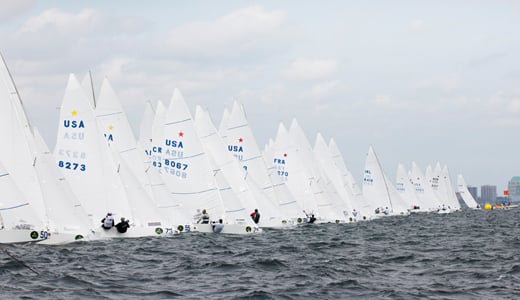
Ireland's O'Leary and Burrows start mid line in race two. Photo: Daniel Forster
After two days of maintaining a lead in the 41-boat Men's 470 class, Nic Asher/Elliot Willis (GBR) were edged out today (day three) by fellow national teammates Luke Patience/Stuart Bithell for the top spot on the scoreboard. Patience/Bithell won today's single race while Asher/Willis took a sixth, using it as a discard race. (After six races, teams are allowed to drop their worst score.) They are now three points behind the new leaders.
"It was a tricky day," said Asher, who with Willis has won the Men's 470 Worlds twice. The wind was off the land so it was shifty and gusty, lots of places changed, but our sixth was solid. Tomorrow it's all to play for."
Patience said his team's victory today came after a disappointing start. "We didn't pop out in front until about two-thirds up the second windward leg; that's pretty late in the race, but as it developed, the lanes opened up. There was not much pattern to the wind, which went from 10 knots up to 15 knots, so it was an active kind of sailing-- a lot of dividing our time between looking around and driving."
Leaders from day one in the 24-boat Women's 470 class, Ingrid Petijean/ Nadege Douroux (FRA), had a "disappointing" race—a 12th—but still hang on for a one-point lead over Penny Clark (GBR), who won today's race to move to second
"Before the start, you could see the dark clouds approaching," said US Sailing Team AlphaGraphics 470 coach Mark Ivey (San Francisco, Calif.), and the teams were scrambling to adjust their rig settings for high wind, but as the race went on, the squall line passed, more toward the Star course (farther out), and it lightened into a leftover westerly breeze."
The 470s are in for a long day tomorrow, as it is anticipated they will sail three races to catch up with their two-races-a-day schedule before the final medal races (for top-ten in each of the ten Olympic classes) conclude the regatta on Sunday.
With two races today in the 56-boat Star class, Robert Scheidt/Bruno Prada (BRA) still shine. They finished 9-7 while Fredrik Loof/Max Salminen (SWE) posted a 15-5. Only two points separate them from the leaders and the third-place finishers Xavier Rohart and Pierre Alexis Ponsot (FRA).
Yet another GBR team leads the 49ers, and they have done so since yesterday in the 29-boat fleet. John Pink/ Rick Peacock finished 4-6-1 today and used the sixth as a permitted discard in their final score, which is 18 points to the 19 carried by Dave Evans/Edward Powys, also from the UK.
The 49er, a skiff that flies across the water with its skipper and crew hanging out over the water on "trapezes," is considered the Ferrari of sailboat racing and can reach blazing speeds. The class started in 1995 and parachuted into the Olympic Games in 2000. The fleet has grown substantially over the last decade, attracting sailors from other classes who seek fast and exhilarating racing. Their races are only 30 minutes long, so they can squeeze in up to four races a day in perfect conditions
"It's going well – we've had some great races really and a mixed bag with conditions," said Pink, noting a total of five victories in his team's nine-race score line. "Yesterday was very boat speed oriented and we managed to crack that quite well and today was a lot more shifty so it was more about minimizing risk. The results could have been a lot worse today, so we battled through and we've been enjoying it." Pink and Peacock won a silver medal here at the 2009 Rolex Miami OCR.
"You get a little confidence boost," said Pink about being lucky enough to do well here among so many of the world's leading sailors, "and aside from that it's just a nice place to be with good weather and good training conditions."
For fleet racing in the Olympic classes, the regatta consists of a five-day opening series (Monday – Friday) and a double-point medal race (Saturday). The top 10 finishers in the opening series of each class will advance to the medal race. For match racing (Elliot 6m), which makes its debut in the 2012 Olympic Games, the regatta consists of an opening series, a knockout series, and a sail-off for boats not advancing to the knockout series. Competitors in the Paralympic classes will have five days of fleet racing (Monday-Friday) and no medal race. Medals will be awarded to the top three boats in each Olympic and Paralympic class on Saturday, January 29.
US SAILING has partnered with the city of Miami to provide world-class venues for competition. Additional hosts for the event include Coral Reef Yacht Club, Key Biscayne Yacht Club, Coconut Grove Sailing Club, Miami Rowing Club and Shake-a-Leg Miami. These sailing organizations host classes onshore, as well as help run the on-the-water racing. The Coral Reef Yacht Club also hosts the Opening and Closing Ceremonies.
In addition to title sponsor Rolex Watch U.S.A., US SAILING's 2011 Rolex Miami OCR is also sponsored by AlphaGraphics, Gowrie Group, Chubb Insurance, Sperry Top-Sider, Harken McLube, Trinity Yachts, University of Miami Hospital and Kattack.
A complete roster of competitors can be viewed at the event website, RMOCR.ussailing.org, where real-time racecourse blogging, commentary and fan interaction, regatta results, photos and news updates will be integrated into a live coverage platform once racing begins. Video highlights produced by Gary Jobson and presented by Rolex air daily and are available on-demand on the event website. Fans can also follow the event on Facebook/RMOCR and Twitter/RMOCR.
US SAILING's 2011 Rolex Miami OCR
Top-three Finishes
Day 3
49er (29 boats) – 9 races
1. John Pink/ Rick Peacock (GBR) 4- 1- 5-1-1-1-4-[6]-1 (18)
2. Dave Evans/Edward Powys (GBR) 2- [6]-1-3-3-2-5-1-2 (19)
3. Paul Brotherton/Mark Asquith (GBR) 1-3-2-5-2-[10]-2-10-5 (30)
Laser Radial (58 boats) – 6 races
1. Marit Bouwmeester (NED) [4]-1-3-3-4-1 (12)
2. Evi Van Acker (BEL) 2-2-1-1-7-[16] (13)
3. Paige Railey (USA) 1-[59/BFD]-4-6-2-5 (18)
Laser (104 boats)-6 races
1. Rasmus Myrgren (SWE) [7]-3-1-1-1-3 (9)
2. Paul Goodison (GBR) 1-2-8-1-[53/DSQ]-1(13)
3. Nick Thompson (GBR) [7]-4-1-2-2-5 (14)
Finn (37 boats) – 5 races
1. Giles Scott (GBR) 1-1-1-1-[38/OCS] (4)
2. Brendan Casey (AUS) 3-4-3-[7]-1 (11)
3. Zach Railey (USA) 2-3-4-[6]-4 (13)
470 Men (42 boats) – 5 races
1. Luke Patience/Stuart Bithell (GBR) 3-2-2-[5]-1(8)
2. Nic Asher/Elliot Willis (GBR) 1-3-5-2-[6] (11)
3. Mathew Belcher/ Malcolm Page (AUS) 2-8-[10]-3-3(16)
470 Women (24 boats) – 5 races
1. Ingrid Petijean/ Nadege Douroux (FRA) 1-2 3-4-[12] (10)
2. Penny Clark/ Katrina Hughes (GBR) 4-4-2-[6]-1 (11)
3. Camille Lecointre/Mathilde Geron (FRA) 3-1-1-8-[25/BFD] (13)
Skud-18 (7 boats) – 5 races
1. Daniel Fitzgibbon/Liesl Tesch (AUS) 1-1-4-1-[8/OCS] (7)
2. Jennifer French/ Jean-Paul Creignou (USA) [3]-3-1-2-2 (8)
3. Alexandra Rickham/Niki Birrell (GBR) 2-4-3-[5]-1 (10)
Star (57 boats) – 6 races
1. Robert Scheidt/Bruno Prada (BRA) 1-2-[9]-1-9-7 (20)
2. Fredrik Loof/Max Salminen (SWE) 5-3-7-3-[15]-6 (24)
3. Xavier Rohart/Pierre Alexis Ponsot (FRA) [7]-7-1-6-7-5 (26)
RS: X Men (37 boats) – 6 races
1. Dorian van Rijsselberge (NED) 1-[4]-1-1-2-4 (9)
2. Nick Dempsey (GBR) 2-2-[4]-4-3-1 (12)
3. Nimrod Mashiah (ISR) 7-3-2-2-1-[11] (15)
RS: X Women (30 boats) – 6 races
1. Marina Alabau (ESP) [1]-1-1-1-1-1 (5)
2. Bryony Shaw (GBR) [7]-2-2-2-2-6 (14)
3. Charline Picon (FRA) 2-6-3-5-[9]-2 (18)
2.4mR (30 boats) – 4 races (No Races Sailed Today)
1. Damien Seguin (FRA) 2-5-1-1 (9)
2. Allan Leibel (CAN) 3-2-2-2 (9)
3. Thierry Schmitter (NED) 1-1-4-4 (10)
Sonar (12 boats) – 5 races
1. John Roberston/ Hannah Stodel/ Steve Thomas (GBR) 3-2-1-[7]-2 (8)
2. Albert Foster/David Burdette/Mike Hersey (USA) 1-[12]-5-1-5 (12)
3. Udo Hessels/ Mischa Rossen/Marcel van de Veen (NED) 2-1-4-[13/DNS]-6 (13)
Elliott 6m -- Gold Round Robin Results
Lucy Macgregor/Mary Rook/ Kate Macgregor (GBR); 2-1
Claire Leroy/ Elodie Bertrand/Marie Riou (FRA); 2-1
Anna Tunnicliffe(/Molly Vandemoer/Debbie Capozzi (Plantation, Fla., USA/Redwood City, Calif., USA/(Bayport, N.Y., USA);2-1
Ekaterina Skudina/Elena Syuzeva/Irina Lotsmanova (RUS); 2-1
Silja Lehtinen/Silja Kanerva/Mikaela Wulff (FIN); 1-2
Nicky Souter/Jessica Eastwell/Olivia Price (AUS); 0-3
Repechage Round Robin Results
Stephanie Hazard/ Susannah Pyatt/ Jenna Hansen (NZL); 3-0
Julie Bossard/Pauline Chalaux/ Nolwenn Combeaux (FRA); 2-1
Sally Barkow (Nashotah, WI., USA)/ Alana O'Reilly (Charleston SC, USA)/ Elizabeth Kratzig-Burnham (Miami Beach FL, USA); 2-1
Renee Groeneveld/Mandy Mulder/Merel Witteveen(NED);1-2
Lotte Meldgaard Pedersen/Christina Refn/Susanne Boidin (DEN); 1-2
Rita Goncalves/Mariana Lobato/Diana Neves (POR); 0-3
Silver Round Robin Results- No Races Sailed
Silke Hahlbrock/ Kerstin Schult / Maren Hahlbrock (GER)
Genny Tulloch/Alice Leanoard/Jennifer Chamberlin (Sausalito, CA.,USA/East Haven, CT., USA/Washington, DC., USA)
Anne-Claire Le Berre/ Alice Ponsar/ Myrtille Ponge (FRA)
Anna Kjellberg/ Malin Kallstrom/ Lotta Harrysson (SWE);
Renata Decnop/Fernanda Decnop/Tatiana Ribeiro (BRA);
Katie Spithill/Nina Curtis/Angela Farrell (AUS);
Bronze Round Robin Results
Vesna Dekleva Paoli/ Katarina Kersevan/ Lena Koter (SLO); 2-0
Annemiek Bekkering/ Brechtje van der Werf/ Annemiek Bes(NED); 1-1
Rebecca Dellenbaugh (Easton CT, USA)/ Maggie Shea (Wilmette, IL USA)/ Janel Zarkowsky (Annapolis, MD USA); 1-1
Jinny Gordon/Crystle Numan/ Laurel Gordon-Taylor (CAN); 0-2
Juliana Senfft/Gabriela Sa/Daniela Adler (BRA); 1-1
Katie Abbott/ Joanne Prokop/ Caroline Kaars Sijpesteijn (CAN); 1-1
That's the Spirit, Dun Laoghaire Regatta Signs up Volvo!
The Dun Laoghaire Regatta team has announced its long term sponsor Volvo will continue their long association with the regatta.
Volvo Car Ireland will sponsor the 2011 event in association with Spirit Motor Group, a dealership for Volvo in South Dublin.
"Sailing is a global platform for Volvo with our global involvement in the sport including the Volvo Ocean Race and we are proud to continue our association with this superb inshore regatta organised by the 4 waterfront yacht clubs in Dun Laoghaire" commented David Baddeley, Managing Director Volvo Car Ireland.
Given the challenging economic environment this announcement illustrates the confidence of Volvo Car Ireland in the ongoing recovery in the Irish economy and the belief in the regatta as a marketing platform for the brand.
"Spirit Motor Group are delighted to work with Volvo Car Ireland and the Dun Laoghaire Regatta Committee to ensure a winning partnership for customers and the important sailing community that participate in the event" commented Alan Moore, Dealer Principal, Spirit Motor Group.
Adam Winkelmann, Chairman of the 2011 Volvo Dun Laoghaire Regatta Committee added "like all events we rely enormously on the support of our sponsors to run the event. The regatta relies heavily on sponsorship and an army of volunteers to deliver a quality event at an affordable price. We are really delighted that Volvo Car Ireland, our long-standing title sponsor, continues as our primary brand partner in that regard. We welcome Spirit Motor Group as a new and very important addition to the mix."
The biennial Volvo Dun Laoghaire Regatta will attract in the region of 500 boats and 3,000 participants along with families and friends to Dun Laoghaire in July next year. The sailors come mainly from Ireland and the UK from where we expect at least the same number of visitors as 2009. The event promises an important boost to the local economy of Dun Laoghaire town in the middle of the summer season. The regatta prides itself in delivering quality racing along with a wonderful festive atmosphere across the Dun Laoghaire waterfront.
This announcement is timed to coincide with the launch of the 2011 Volvo Dun Laoghaire Regatta official Notice of Race and Online Entry which is now available on www.dlregatta.org
Calves Week 2011 Notice of Race and Entry form Published
Electro to Sponsor Howth Yacht Club Lambay Races
The annual Howth Yacht Club Lambay Race - Howth Regatta - is to be called the Electro Lambay Race following confirmation of sponsorship by Electro Automation Group, widely regarded as Ireland's premier automation specialist and an international leader in such areas as automated car park systems, gate and door access control systems, and intelligent transportation systems.
The race takes place on June 12 and online entry is available now. (see below)
Operating from headquarters in Damastown, near Mulhuddart, Electro was established in 1984 and now has operations in Lisburn, Galway, the UK, and Germany. The Electro brand is synonymous with advanced technology and service reliability across a wide range of products that control movements of personnel and vehicles, automatic gates and bollards, doors and barriers, hands-free access control, under-vehicle surveillance and CCTV security.
The Electro sponsorship will include a significant input into the 'family day' theme of this year's sailing which is expected to attract around 140 boats and over 1,000 sailors and visitors.
Cork Week: Cork Revealed, with Eddie English
Cork Week Revealed
with Eddie English (reprinted from Afloat 2006)

Eddie English stands high on Cobh’s historic waterfront and looks out across Cork Harbour, south towards Roche’s Point lighthouse and the entrance to the natural sailing sanctuary. Immediately below, a huge Brittany Ferries ship heads slowly out to sea; it’s not even close in size to a previous visitor to the former Queenstown, but then again, the RMS Titanic belonged to a different era.
To his left, the inshore waters north of the Whitegate oil refinery hide the channel to East Ferry where the Marlogue Inn stands over its marina and just opposite, the legendary Murphs on the mainland shore.
On his right, the channel between Spike and Haulbowline Islands and Cobh is the main shipping route for the Port of Cork for ferries, commercial shipping and the Irish Naval Service base.
But it’s the view straight out to sea that confirms one of the magic ingredients that have made Cork Week an international regatta of worldwide repute: vast tracts of open, unobstructed water and all within easy reach of the shoreside facilities of the hosts at the Royal Cork Marina at Crosshaven.
When it comes to local knowledge, few are as expert as English. Not only is he a former chairman of the event's racing committee, not only does he run a long-established sailing school in the harbour, but when you are offered an insight from someone who takes his dog for a walk on notorious mud banks at low water springs, they tend to be nuggets of the golden variety.
"The harbour course is the key to Cork Week," says English. "It's the decider where the event is won or lost and has the most variables involved." So this, then, is the Eddie English step-by-step guide to gaining an edge for that course, plus the coastal, wind/leeward and Olympic-type courses at Cork Week.
COPYRIGHT – AFLOAT MAGAZINE 2006






























